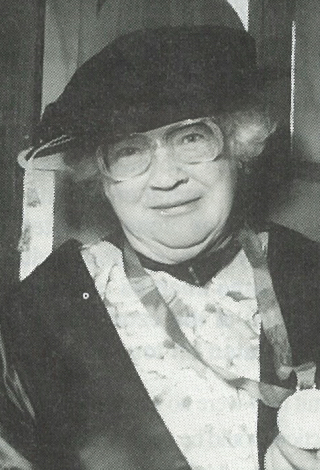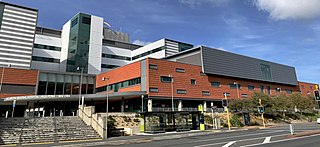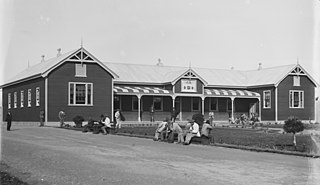
Janet Paterson Frame was a New Zealand author. She is internationally renowned for her work, which includes novels, short stories, poetry, juvenile fiction, and an autobiography, and received numerous awards including being appointed to the Order of New Zealand, New Zealand's highest civil honour.

Dunedin is the second-largest city in the South Island of New Zealand, and the principal city of the Otago region. Its name comes from Dùn Èideann, the Scottish Gaelic name for Edinburgh, the capital of Scotland. The city has a rich Māori, Scottish, and Chinese heritage.

The small town of Karitane is located within the limits of the city of Dunedin in New Zealand, 35 kilometres to the north of the city centre.

Friern Hospital was a psychiatric hospital in the parish of Friern Barnet close to a crossroads which had a hamlet known as Colney Hatch. In 1965, it became part of the London Borough of Barnet and in the early 21st century was converted to residential housing as Princess Park Manor and Friern Village. The hospital was built as the Second Middlesex County Asylum and was in operation from 1851 to 1993. After the County of London was created in 1889 it continued to serve much of Middlesex and of the newer county, London. During much of this time its smaller prototype Hanwell Asylum also operated.

The Royal New Zealand Plunket Trust provides a range of free services aimed at improving the development, health and wellbeing of children under the age of five within New Zealand, where it is commonly known simply as Plunket. Its mission is "to ensure that New Zealand children are among the healthiest in the world". Much of Plunket's work is organised by volunteers.

Emily Hancock Siedeberg-McKinnon was a New Zealand medical practitioner and hospital superintendent. She was also the country's first female medical graduate.

The Octagon is the city centre of Dunedin, in the South Island of New Zealand. It is an eight-sided plaza with a circular one-way carriageway, bisected by the city's main street, and is also the central terminus of two other main thoroughfares. The Octagon is predominantly a pedestrian reserve, with grass and paved features, and is surmounted by a statue of the Scottish poet Robert Burns. Several of Dunedin's significant buildings and institutions adjoin the plaza, which is also a major hub for public transport in Dunedin, primarily taxi services.

Robert Arthur Lawson was one of New Zealand's pre-eminent 19th century architects. It has been said he did more than any other designer to shape the face of the Victorian era architecture of the city of Dunedin. He is the architect of over forty churches, including Dunedin's First Church for which he is best remembered, but also other buildings, such as Larnach Castle, a country house, with which he is also associated.

Sir Frederic Truby King, generally known as Truby King, was a New Zealand health reformer and Director of Child Welfare. He is best known as the founder of the Plunket Society.

Dunedin Hospital is the main public hospital in Dunedin, New Zealand. It serves as the major base hospital for the Otago and Southland regions with a potential catchment radius of roughly 300 kilometres, and a population of around 300,000.

Wellington Hospital, also known as Wellington Regional Hospital, is the main hospital in Wellington, New Zealand, located south of the city centre in the suburb of Newtown. It is the main hospital run by Te Whatu Ora, Capital, Coast and Hutt Valley.
Seacliff is a small village located north of Dunedin in the Otago region of New Zealand's South Island. The village lies roughly halfway between the estuary of Blueskin Bay and the mouth of the Waikouaiti River at Karitane, on the eastern slopes of Kilmog hill. Coast Road, an old route north from Dunedin, and the South Island Main Trunk Railway pass through the village.
Hawksbury, also known as Cherry Farm, is a small residential and industrial area in New Zealand, located beside State Highway 1 between Dunedin and Waikouaiti.

Sunnyside Hospital (1863–1999) was the first mental asylum to be built in Christchurch, New Zealand. It was initially known as Sunnyside Lunatic Asylum, and its first patients were 17 people who had previously been kept in the Lyttelton gaol. In 2007, Hilmorton Hospital is just one of the mental health services that are based on the old Sunnyside Hospital grounds.
Scottish New Zealanders are New Zealanders of Scottish ancestry or who originate from Scotland. The number of New Zealanders who are descended from Scots is unknown, as the New Zealand census asks for ethnicity, not ancestry, and most have now assimilated; nonetheless, the vast majority of Pākehā, or European New Zealanders are of British and Irish descent, and it has been estimated that 1-2 million New Zealanders have roots in Scotland. This includes many Māori, as a large proportion of which have European roots as well. Most Scottish New Zealanders live in New Zealand's deep southern regions of Otago and Southland, New Zealand, where they have had a substantial influence. Scottish influence on Dunedin, one of New Zealand's most historically important cities was profound, and Presbyterianism is the major religion south of Christchurch. In some parts of Otago but all of Murihiku, there is a distinct accent known as the "Southland Brrr", which differs from mainstream New Zealand English for being strongly rhotic.

The Seaview Asylum was a psychiatric hospital located to the north of Hokitika, in the West Coast Region of New Zealand's South Island, adjacent to the former Westland Hospital. Open from 1872 to 2009, Seaview trained psychiatric nurses and was once the town's biggest employer.
Hanorah Philomena FitzGibbon MBE was a New Zealand civilian and military nurse, hospital matron and nursing administrator.

The New Zealand Exhibition, which took place in Dunedin, New Zealand, in 1865, was a world's fair visited by approximately 31250 people. It was the first world's fair held in New Zealand. It opened on 12 January and ran until 6 May 1865.
The Karitane Hospitals were six hospitals in New Zealand run by the Plunket Society, located in Auckland, Christchurch, Dunedin, Invercargill, Wanganui and Wellington. They were established as training hospitals for Karitane nurses and cared for babies with malnutrition and other dietetic complaints, and premature babies. They also offered mother care training and assistance. The first hospital opened in 1907 and the hospitals were closed between 1978 and 1980 due to financial difficulties and changes in society and maternity services.

Mental health in New Zealand generally follows the trends of mental health in other OECD countries. New Zealand's 'outdoor life style' and high standard of living are balanced by isolation and a self-reliant culture, which discourages asking for help. Historically, people with mental health problems were institutionalised, whereas now the focus is on care in the wider community. The stigma around poor mental health has been lessened in recent years as a result of this change and public education campaigns. However, New Zealand's minorities and youth continue to be over-represented in the negative mental health statistics.





















